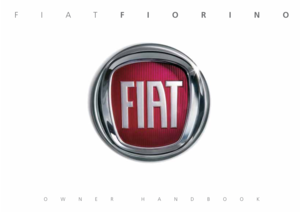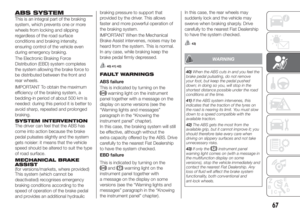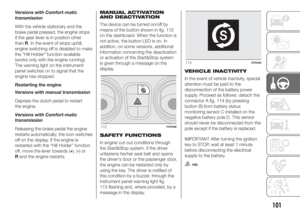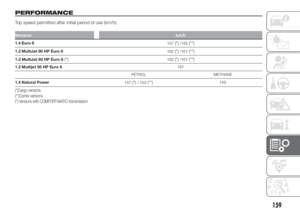Page 33 of 196

SECURING YOUR LOAD
Hooks (various number, according to
version) are fixed to the floor for easy
securing load.
Cargo versions fig. 54;
Combi versions fig. 55.
LOADING ADVICE
Some simple suggestions can improve
driving safety, comfort and vehicle
duration: - distribute the load evenly
over the platform: if it must be
concentrated it in a single area, choose
an area mid-way between both axles;- lastly, remember that the dynamic
behaviour of the vehicle is affected by
the transported weight: in particular, the
stopping distances are longer,
especially at high speed.
24) 25) 26) 27)
WARNING
24)Bumpy roads and abrupt braking may
cause unexpected load shifting with
consequently hazardous situations for the
driver and passengers: before setting
off, secure the load tightly using the
partition and appropriate hooks, steel
cables, ropes or chains strong enough to
hold the items to be secured.
25)Even when the car is stopped on a
steep hill or side slope, opening the rear or
side doors could cause unsecured goods
to fall out.
26)If you wish to carry a reserve of petrol
in a can, observe the legal restrictions
and only use a can that is type-approved
and properly secured to the load
anchorage eyebolts. In the event of a
collision the fire risk is increased all the
same.
27)Each of these must be strictly observed
and MUST NEVER BE EXCEEDED in any
case. In particular, ensure that you never
exceed the maximum permitted weights on
the front and rear axles when arranging
the load on the vehicle (particularly if the
vehicle is equipped with a specific trim
level).
LUGGAGE
COMPARTMENT
EMERGENCY OPENING
FROM THE INSIDE
In the event of an emergency, you can
open the tailgate from inside as follows:
open the sliding side door and
lower the backrest of the rear seat to
gain access to the boot (Combi
versions);
or
open the sliding side door (Cargo
versions);
use device A fig. 56 located on the
inside of the right-hand swing door;
open the left-hand swing door
by pulling the handle (see "Doors" in
this section).
28) 29)
54F0T0057
55F0T0058
56F0T0060
31
Page 34 of 196

REMOVING THE PARCEL
SHELF (Combi versions)
(for versions/markets, where provided)
The parcel shelf fig. 57 consists of
two parts. To remove it completely,
proceed as follows:
open the rear swing doors and lift
the front part A fig. 57 by releasing the
pin A fig. 58 from the seat F fig. 58;
lift the rear part B fig. 57 by releasing
the pins B and C fig. 58 from the seat
D and E fig. 58.If the seat is completely folded down,
remove the parcel shelf as described
and store it horizontally between the
back of the front seats and the folded
rear seat.
To refit the parcel shelf, follow the same
procedure in reverse.
30)
EXTENDING THE BOOT
Proceed as follows:
open the rear doors and remove the
parcel shelf (as described previously);
completely lower the rear seat head
restraints;
move the seat belt to the side,
making sure that it is fully extended and
not twisted;
lift backrest retainer lever A fig. 59
and fold the backrest forwards to
obtain a flat loading area. When you lift
the lever, you will see a red band.To further expand the boot, pull tab A
fig. 60 behind the rear backrest and tip
seat and backrest forward.
REMOVING THE REAR
SEAT
The rear seat can be removed to carry
large loads and expand the boot even
further.
Combi versions
Operate the two brackets A fig. 61
under the side of the seat (one on each
side) after having tipped the rear seat
as previously described.
REPOSITIONING THE
REAR SEAT
Proceed as follows:
check that the seat belt webbing is
correctly inserted in the corresponding
bracket:
57F0T0062
58F0T0456
59F0T0921
60F0T0065
32
KNOWING YOUR VEHICLE
Page 35 of 196

take the cushion back to horizontal
position and check that it is secured
correctly;
tip back the backrest and check that
it is secured correctly.
A pictogram (fig. 62) is located under
the split seat cushion showing how
to secure the seat back onto the
brackets screwed to the floor.
WARNING
28)If you are travelling in areas with few
filling stations and you want to transport
fuel in a spare tank, comply with the law by
using only an approved, suitably secured
tank. In the event of a collision the fire
risk is increased all the same.
29)Never exceed the maximum allowed
load in the boot (see "Technical
Specifications" section). Also make sure
that the objects you place in the luggage
compartment have been properly secured,
to avoid them from being thrown forward
consequent to sudden braking and injuring
your passengers.
30)You must not use the folded rear seat
to carry luggage. The load could be thrown
forward into the backrest of the front
seats, seriously injuring the occupants.
VERSION WITH
METHANE SYSTEM
(Natural Power)
31) 32) 33)
5) 6) 7)
INTRODUCTION
The Fiat Fiorino Natural Power version
features two fuel systems, one for
petrol and one for natural gas
(methane).
Selecting the type of fuel supply
Fiat Fiorino Natural Power is configured
to run normally on methane gas.
When the methane is running out and
the pressure in the cylinder is close
to the correct operating limit, the
system automatically switches to petrol
operation.
The engine always starts up on petrol,
with automatic switching to methane
when the best conditions are achieved
(engine water temperature, minimum
engine rpm limit) for switching to
methane.
Therefore, there must always be some
petrol in the tank (at least 1/4 full), in
order not to compromise the operation
of the fuel pump.61F0T0199
62F0T0302
33
Page 36 of 196

For this reason there must always
be petrol in the tank.
The petrol/methane switch fig. 63,
amongst the controls in the dashboard,
makes it possible to select petrol
operation. The system does not switch
automatically to methane operation if
the petrol runs out.
IMPORTANT If gas is smelled, switch
from methane operation to petrol
operation and immediately go to a Fiat
Dealership to have the vehicle checked
and possible system faults excluded.
CYLINDERS
The vehicle has two cylinders (total
capacity about 77 litres) located under
the floor and protected by two special
guards.
The cylinders fig. 64 and fig. 65 are the
tank that contains methane in
compressed gaseous state (200 rated
bar at 15 °C).The methane, stored in the canisters at
high pressure, flows through a
dedicated pipe to reach the pressure
regulator/reduction unit which supplies
the 4 methane injectors at low pressure
(about 6 bar).
Cylinder capacity: about 13 kg. The
amount of methane depends on the
outside temperature, the supply
pressure, the quality of the gas and the
type of refuelling system. Total cylinder
volume about 77 litres.Cylinder certification
The methane canisters are certified in
accordance with EEC Regulation 110.
The cylinders must be inspected, in
accordance with ECE Regulation
Procedure no. 110, every 4 years
from the vehicle registration date or
in accordance with specific
regulations in individual countries.
PETROL/METHANE
SWITCH
This engine normally runs on methane
except during starting when it runs
on petrol. Switching to methane takes
place automatically and is shown on
the instrument panel display by
switching off the
signal in the display.
Methane fuel reserve
The level of methane in the cylinders is
indicated by the four vertical bars
near the word CNG on the instrument
panel display fig. 66. When the residual
amount of methane is lower than 1/5
of the capacity of the cylinders, the first
level and the edges of the bars of the
other 3 levels flash until the next
methane refuelling. A specific message
will appear on the display in addition
to an acoustic warning.63F0T0343
64F0T0345
65F0T0356
34
KNOWING YOUR VEHICLE
Page 37 of 196

If the methane has run out, switching to
petrol takes place automatically. In this
case the display shows the
icon
just above the CNG wording and all the
bars of the edges for the empty
notches light up constantly, regardless
of the type of supply; see fig. 67 or
fig. 68.If you want the car to run on petrol,
press the button fig. 69 located
between the controls in the dashboard.
The LED on the button switching on
indicates that the request for switching
has taken place correctly.The actual change to the chosen fuel
system takes place depending on
the vehicle usage conditions to
guarantee switching in absolute safety
and will be confirmed by the
warning
light in the instrument panel display
coming on/going off.
Manual switching of the operating
mode from petrol to methane and
vice versa only occurs if the engine
speed is below 2000 rpm.
In addition, in the case of starting at
outside temperatures of below around
-10°C, the switching times from Petrol
to Methane increase to allow the
pressure regulator/reduction unit to
become warm enough.
IMPORTANT If switching takes place
during acceleration or pick-up, there
may be a brief flat spot (drop in power).
66F0T0462
67F0T0382
68F0T0383
69F0T0343
35
Page 38 of 196

WARNING
31)The Fiat Fiorino Natural Power is
equipped with a high pressure methane
fuel supply system, designed to operate at
a rated pressure of 200 bar. It is dangerous
to stretch the system with higher
pressures. To prevent damage to the
methane system parts when towing or
lifting the vehicle, follow the instructions in
the main handbook in the chapter: "Towing
the vehicle". If there is a problem with the
methane system, only contact a Fiat
Dealership. Do not alter the methane
system configuration or components. They
are designed exclusively for the Fiat
Fiorino Natural Power. The use of other
components or materials could cause
malfunctions and prejudice safety.
32)When oven painting, the cylinders must
be removed from the vehicle and refitted
by a Fiat Dealership. Although the methane
system has numerous safety features, it is
advisable to close the manual tap on the
cylinders every time the vehicle is not
in use for a long period, transported on
other vehicles or moved in an emergency
as a result of a breakdown or accident.
33)If gas is smelt, switch from methane
operation to petrol operation and
immediately go to a Fiat Dealerships to
have the vehicle checked and possible
system faults supply excluded.
WARNING
5)Regardless of the last fuel system used,
at the following engine starting, after the
initial petrol stage, the system will
automatically switch to methane.
6)At the time of the switching request
there will be a metallic noise from the
valves which are pressurising the circuit
(more obvious with the ignition key in
the MAR-ON position). For the switching
logic described above, a delay between the
valve ticking and the switching off of the
instrument panel indication is completely
normal.
7)Do not switch between the two
operating modes whilst starting the engine.
36
KNOWING YOUR VEHICLE
Page 39 of 196

KNOWING THE INSTRUMENT PANEL
This section of the handbook gives you
all the information you need to
understand, interpret and use the
instrument panel correctly.INSTRUMENT PANEL ..................... 38
DIGITAL DISPLAY............................ 42
MULTIFUNCTION DISPLAY ............. 43
TRIP COMPUTER ........................... 44
WARNING LIGHTS AND
MESSAGES .................................... 46
-LOW BRAKE FLUID/HANDBRAKE
ENGAGED........................................... 46
-EBD FAILURE .................................... 47
-AIR BAG FAILURE .............................. 47
-SEAT BELTS REMINDER.................... 48
-GEARBOX FAILURE ........................... 48
-ENGINE COOLANT TEMPERATURE
TOO HIGH........................................... 49
-LOW BATTERY CHARGE ................... 49
-INSUFFICIENT ENGINE OIL
PRESSURE/ENGINE OIL
DETERIORATED .................................. 50
-LOW ENGINE OIL LEVEL ................... 51
-DOOR OPEN ..................................... 51
-POWER STEERING FAILURE ............. 51
-INJECTION SYSTEM FAULT (Multijet
versions) - EOBD ENGINE CONTROL
SYSTEM FAULT (petrol versions) ......... 52
-ABS FAILURE..................................... 53
-FUEL RESERVE ................................. 54
-PLUG PREHEATING (Multijet
versions) - PLUG PREHEATING FAULT
(Multijet versions) ................................. 54
-WATER IN DIESEL FILTER (Multijet
versions) .............................................. 55
-VEHICLE PROTECTION SYSTEM
FAULT - FIAT CODE - ALARM FAULT
(for versions/markets, where provided
- amber) - BREAK-IN ATTEMPT .......... 56
-GENERAL FAILURE INDICATION ....... 57-DPF (PARTICULATE FILTER)
CLEANING UNDERWAY ...................... 59
-HILL HOLDER FAILURE ..................... 59
-iTPMS ................................................ 60
-BRAKE PAD WEAR ............................ 60
-PARKING SENSOR FAILURE ............. 60
-START&STOP SYSTEM FAILURE....... 60
-ASR SYSTEM DEACTIVATED ............. 61
-TRACTION PLUS SYSTEM
ACTIVATION ........................................ 61
-REAR FOG LIGHTS............................ 61
-SIDE LIGHTS - FOLLOW ME HOME .. 62
-LEFT-HAND DIRECTION INDICATOR
(blinking) .............................................. 62
-RIGHT-HAND DIRECTION
INDICATOR (blinking) ........................... 63
-FRONT FOG LIGHTS ......................... 63
-CRUISE CONTROL ............................ 63
-MAIN BEAM HEADLIGHTS ................ 63
-GEAR SHIFT INDICATION .................. 64
-CNG SYSTEM FAILURE ..................... 64
37
Page 40 of 196
INSTRUMENT PANEL.
.
Versions with digital display
Warning lights
andare available on diesel versions only.
A. Speedometer – B. Fuel level gauge with reserve warning light – C. Engine coolant temperature indicator with overheating warning light – D. Rev
counter – E. Digital display
70F0T0807
38
KNOWING THE INSTRUMENT PANEL
 1
1 2
2 3
3 4
4 5
5 6
6 7
7 8
8 9
9 10
10 11
11 12
12 13
13 14
14 15
15 16
16 17
17 18
18 19
19 20
20 21
21 22
22 23
23 24
24 25
25 26
26 27
27 28
28 29
29 30
30 31
31 32
32 33
33 34
34 35
35 36
36 37
37 38
38 39
39 40
40 41
41 42
42 43
43 44
44 45
45 46
46 47
47 48
48 49
49 50
50 51
51 52
52 53
53 54
54 55
55 56
56 57
57 58
58 59
59 60
60 61
61 62
62 63
63 64
64 65
65 66
66 67
67 68
68 69
69 70
70 71
71 72
72 73
73 74
74 75
75 76
76 77
77 78
78 79
79 80
80 81
81 82
82 83
83 84
84 85
85 86
86 87
87 88
88 89
89 90
90 91
91 92
92 93
93 94
94 95
95 96
96 97
97 98
98 99
99 100
100 101
101 102
102 103
103 104
104 105
105 106
106 107
107 108
108 109
109 110
110 111
111 112
112 113
113 114
114 115
115 116
116 117
117 118
118 119
119 120
120 121
121 122
122 123
123 124
124 125
125 126
126 127
127 128
128 129
129 130
130 131
131 132
132 133
133 134
134 135
135 136
136 137
137 138
138 139
139 140
140 141
141 142
142 143
143 144
144 145
145 146
146 147
147 148
148 149
149 150
150 151
151 152
152 153
153 154
154 155
155 156
156 157
157 158
158 159
159 160
160 161
161 162
162 163
163 164
164 165
165 166
166 167
167 168
168 169
169 170
170 171
171 172
172 173
173 174
174 175
175 176
176 177
177 178
178 179
179 180
180 181
181 182
182 183
183 184
184 185
185 186
186 187
187 188
188 189
189 190
190 191
191 192
192 193
193 194
194 195
195






